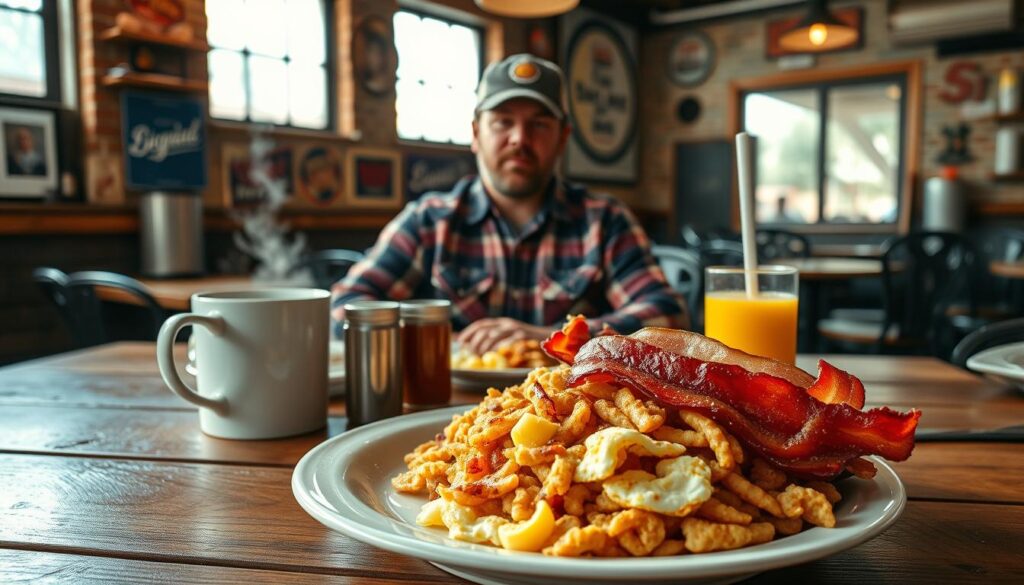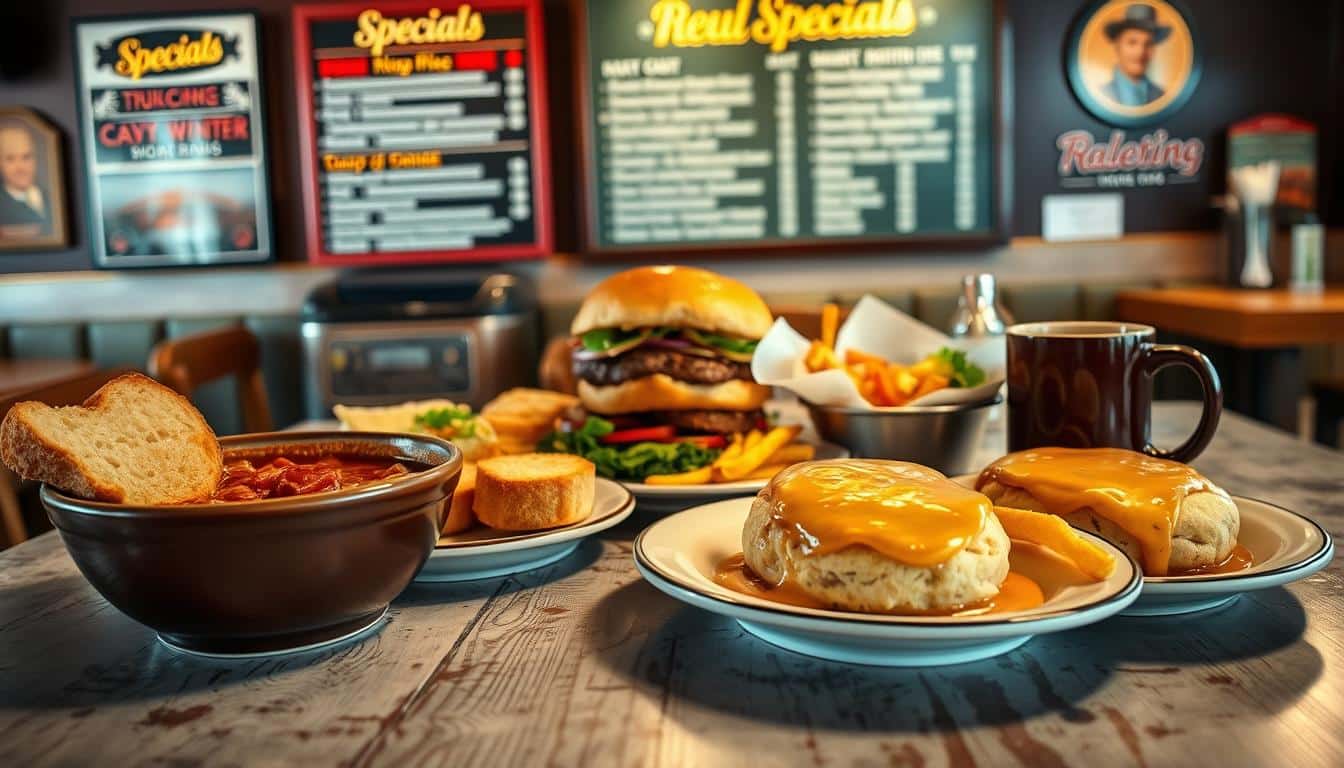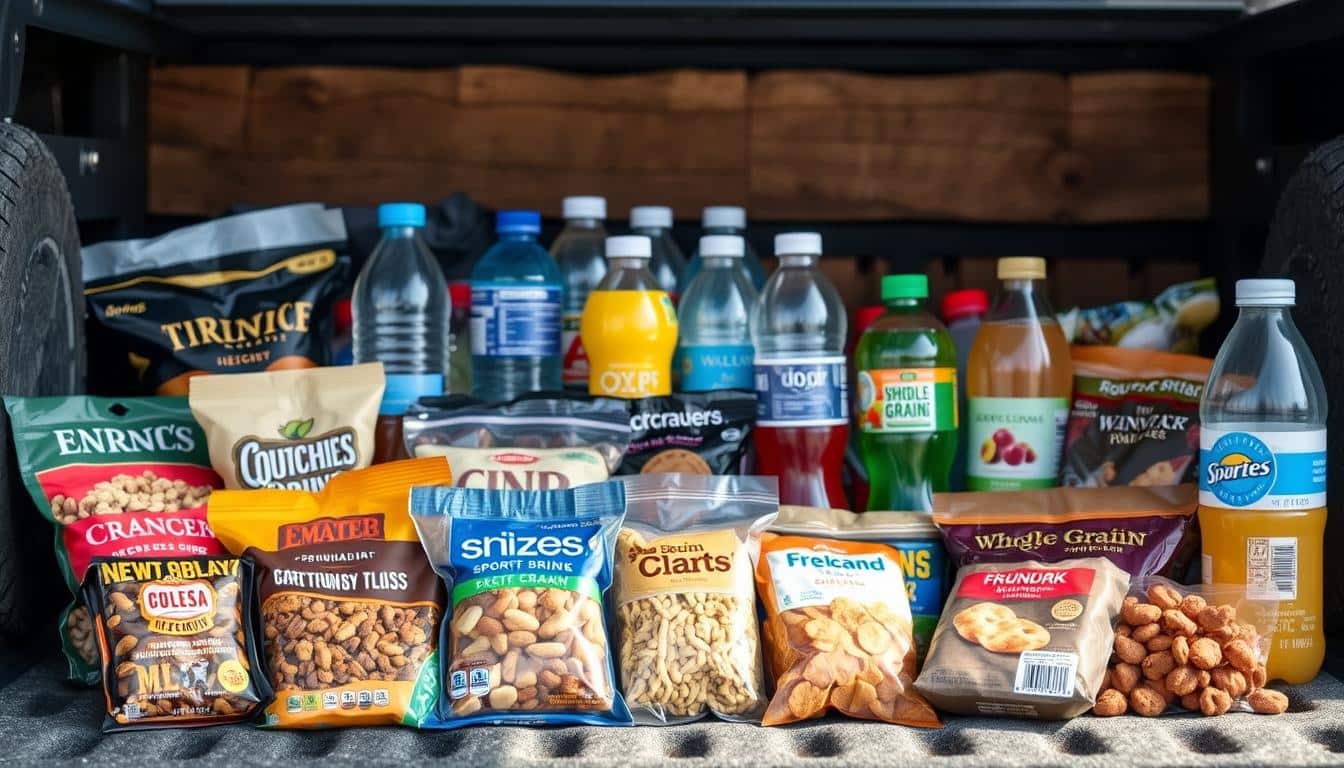Long-haul routes can make it hard to cook. Many drivers end up eating at truck stops, which can be unhealthy. By prepping meals, you save money and eat better.
With a little planning, your cab becomes a mini-kitchen. Use small fridges, insulated bags, and slow cookers. These items help keep your food fresh and warm.
Truckers can batch cook meals, use freezer recipes, and make smoothie packs. This means you can avoid fast food. You keep eating well while on the move.
Tools like mobile apps and checklists make finding healthy recipes easy. With some planning, meal prep is simple. It leads to more energy, cost savings, and better health while traveling.
Why Meal Prep Matters for Long-Haul Drivers
Long hours driving can make finding good food hard and urgent. Having meals ready gives control back to the driver. Meal prep is more than just handy for truckers. It keeps them healthy during tough routes.
Health benefits of planned meals on the road
Meal prep cuts down on high calories, fat, and salt found at diners. Eating right with good portions and veggies helps truckers stay fit and healthy.
Having a good breakfast and regular meals keeps blood sugar stable. It means better endurance during long hauls and less chance of feeling tired suddenly.
Cost savings versus frequent truck-stop meals
Batch cooking and smart shopping help save money. Prepping meals means spending less on fast food and snacks you don’t need.
Planning meals in advance lowers daily spending and helps the budget on long trips. Truckers save money and time looking for food.
How meal planning supports energy, alertness, and safety
Eating right keeps a driver alert by avoiding sugar highs and lows. Foods rich in protein and grains provide lasting energy for safer driving.
Good nutrition is key to feeling energetic and clear-headed. Having meals and snacks ready reduces tiredness and keeps a trucker alert on the road.
Essential Gear for Meal Prep in a Truck Cab
Good gear can make cooking in a truck cab easy and trusty. Choose items that can plug into a 12-volt outlet, don’t need the internet, and can keep food safe. With the right tools, drivers can eat better, save money, and skip fast food.
- Pick a 12V cooler for keeping things cold on long trips. A small fridge in your truck can keep dairy, fresh fruit, and meal preps good for days.
- Go for ones with easy-to-use temperature control. This way, you avoid technical issues in places with poor phone service.
Small, on-board appliances
- A lunchbox cooker can warm up a sandwich or a small meal without needing a stove. It’s compact and simple to clean.
- A portable slow cooker lets you cook stews and chilis while driving or resting. Just set it up, leave it, and enjoy a warm meal later.
- Thermoses help drivers keep soups, coffees, and stew warm for many hours. Go for ones that are stainless steel and vacuum-insulated to keep food warm without reheating.
Food storage and space-saving tools
- Use reusable containers with secure lids to divide food easily. Pick shallow ones for the fridge and deeper ones for liquids like soups.
- Insulated bags keep chilled food safe during quick stops. They work well with a truck fridge or a 12V cooler for longer trips.
- Choose space-saving items like foldable knives and compact utensils. A little cutting board and stackable bowls help keep your cab neat for quick meal prep.
Practical buying tips
- Manual controls are better than apps when you have weak signals.
- Make sure appliances match your truck’s electric limits to prevent battery issues.
- Choose durable brands and easy-to-clean materials for lasting use.
These items help truckers keep food better and depend less on truck-stop meals. Picking the right gear means enjoying healthier eating with fewer worries.
meal prep tips for truckers
Keeping your meals simple can save you both time and stress. These tips are all about making things work in the small space of a truck. They also help you fit meal prep into a busy schedule. You can use what you already have and shop wisely to make better food choices.
Start small. Begin by preparing a single meal or snacks for one day. Making one dinner or planning a week of lunches can start a good routine. This way, you won’t feel swamped.
Batch cook for the week. For truckers, batch cooking means making lots of chicken, beef, or tofu at once. You also cook a big batch of rice or quinoa. Then, divide these into portions to create different meals throughout the week.
Pre-portion snacks. Put snacks in little bags or containers to avoid eating chips. Try snacks like baby carrots, celery, apple slices, or cheese and crackers. These keep your energy up without the crash.
Use frozen produce. Frozen fruits and veggies last a long time and keep their nutrients. Have frozen berries and veggies ready for smoothies or quick meals. This way, your food won’t go bad in a warm truck.
- Make simple meal prep for truckers more varied by changing sauces and spices.
- For start small meal prep, pick two breakfasts and two dinners to rotate.
- Batch cooking for drivers cuts dishes and saves time during layovers.
- Preportion snacks to control portions and curb late-night cravings.
- Create smoothie packs from frozen produce for truckers to blend quickly at rest stops.
Plan your meals around the same main ingredients. A cooked chicken breast can be used in salads, wraps, or grain bowls. This approach keeps your food exciting and makes meal prep easy to keep up with, even on long journeys.
Easy Breakfast Ideas That Travel Well
Breakfast is key for long trips. Choose foods easy to store, quick to heat, or that don’t need warming. Making smart food choices reduces stops and boosts alertness.

Healthy muffins are perfect for the road. Use oats, nuts, banana, or blueberries in your baking. Keep them in a cooler or insulated bag. They provide energy for longer and are healthier than sugary pastries from truck-stops.
- Use whole-grain flour and Greek yogurt for moist texture.
- Add chia or flax for fiber and satiety.
- Portion into single servings for easy grab-and-go.
Eggs offer lots of protein. You can store boiled eggs in a cooler for several days. Try making an egg bake with leftover veggies and cheese. Use a lunchbox cooker or small oven, then chill it in slices.
- Breakfast burritos wrapped in foil reheat well at truck stops.
- Store hard-boiled eggs in a sealed container to keep your space fresh.
- An egg bake is a time-saver and combines leftovers into a meal.
Smoothie packs make breakfast fast for drivers. Put fruit, spinach, and protein powder in bags and freeze. When ready, blend them for a quick meal or snack.
- Include frozen berries, banana, and greens for nutrition.
- Add nut butter or Greek yogurt for protein and smoothness.
- Mark packs by flavor to make mornings easier.
Mix these portable breakfast ideas for variety. Pair a muffin with an egg or smoothie. Focus on getting proteins, fiber, and healthy fats to keep energy up.
Always have almonds, whole-grain wraps, and hummus cups ready. With a bit of planning, these breakfast ideas can become daily habits that suit life on the move.
Lunch and Dinner Recipes Suitable for the Cab
Make lunches and dinners easy and tasty. Plan meals that can go in an insulated cooler. Use batch-cooked items, frozen veggies, grains, and portioned proteins for variety.
Jar salads stay fresh if layered right. Start with dressing, then add beans or chickpeas, grains, proteins, and greens on top. They’re perfect for drivers and keep well in a cooler.
Protein bowls are great on the go. Mix chicken, tofu, or tuna with quinoa or rice. Add veggies and dressing in separate containers to keep everything fresh.
- Cook protein and grains ahead on Sunday for many meals.
- Freeze veggies to add to bowls and salads easily.
- Use airtight containers and ice packs for freshness.
Wraps and sandwiches are simple and don’t need heating. Use whole-wheat tortillas or flatbreads. Fill them with turkey, avocado, tomato, and mozzarella. Lettuce wraps are lighter and don’t get soggy. Keep them in parchment in an insulated box.
Slow cooker dishes are great for weekends or with power. Cook chili, beef stew, or pulled pork ahead. Use a small Crock-Pot or 12-volt cooker to finish cooking while parked. Cooking ahead is safer and easier.
- Chili: make lots, using beans, lean beef, and tomatoes. Freeze in portions.
- Pulled chicken: cook in barbecue sauce. Serve with rolls or over rice.
- Vegetable stew: mix root veggies and lentils. Goes well with cooked quinoa.
Mixing jar salads, protein bowls, wraps, and slow cooker meals keeps meals interesting. Using the same chicken or rice in different ways saves time.
Have a jar salad, a protein bowl, and a wrap each day. Include a slow-cooker meal twice a week. This keeps trucker meals healthy and energizes during long trips.
Snack and Dessert Options That Stay Healthy on the Road
Pack easy, no-cook snacks to avoid pricey truck-stop food. Keeping healthy snacks on hand helps you make better food choices. It keeps hunger away between stops.
-
Trail mix and nuts: Choose trail mix that blends nuts, seeds, and a bit of dried fruit for energy and protein. Single-serve packs help with portion control and avoid sugary snacks.
-
Cheese and cracker packs: Cheese paired with whole-grain crackers offers quick energy. Add fruit for a balanced snack that keeps you alert.
-
Popcorn and whole-grain chips: Choose air-popped popcorn and baked chips as low-calorie snacks. Flavor them with salt or paprika for taste without extra calories.
Go for fresh snacks when you can’t refrigerate. Fresh fruits and pre-chopped veggies stay good for days. They make healthy snacking quick during breaks.
-
Veggie sticks and hummus: Veggie sticks like carrots and peppers with hummus are easy to eat and satisfying. Hummus cups are mess-free and perfect for the road.
-
Pre-chopped salads: Use jars for salads with hearty greens, beans, and a cup of dressing. It’s a quick, fresh snack without needing to heat anything.
-
Fresh fruit and dried alternatives: Apples, bananas, and oranges are good for travel. Dried fruit satisfies sweet cravings with smaller portions than candy.
For a sweet treat, choose frozen snacks over ones heavy in sugar and fat. Frozen fruits can refresh you without too many calories.
-
Frozen grapes and berries: Freeze grapes or strawberries for a dessert that feels special. They thaw slowly, making them perfect for road trips.
-
Fruit bars and ice pops: Choose fruit bars or ice pops with low sugar or made from 100% fruit. Keep them in a cooler during long drives.
-
Portioned sweets: Pack dark chocolate squares or yogurt chips in small servings. This helps satisfy your sweet tooth without overdoing it.
Prepare snack packs before your trip. Use bags and clear containers to easily see your choices. This planning makes snacks both convenient and healthier than last-minute picks.
Food Safety, Storage, and Reheating Best Practices
It’s important to keep meals safe while traveling. Follow easy steps to ensure food stays fresh, you stay healthy, and you save time. This guide talks about controlling temperatures, thawing food correctly, and safely enjoying both hot and cold dishes.
- Keep perishable foods at 40°F or below. Use a powered 12-volt fridge or quality cooler with ice packs to keep food cold in truck.
- Keep hot foods above 140°F when holding them. A thermos can hold heat long enough for a meal without repeated reheating, reinforcing thermos food safety.
- Use a digital probe thermometer to check internal temps before eating. Raw and cooked items should never share the same container.
Freezer-ready prep and thawing
- Choose freezer-friendly meal prep like casseroles, burritos, and lasagna. These freeze well and reheat safely when handled correctly.
- Thaw in a powered fridge or insulated cooler to keep items in the safe zone. If needed, cook from frozen in a slow cooker or instant pot when allowed.
- Pack frozen fruit and vegetables to extend variety. Frozen produce stays nutrient-dense and reduces reliance on perishables.
Storage and cross-contamination prevention
- Store raw meats on the bottom shelf or in sealed bags to prevent drips onto ready-to-eat foods.
- Use airtight containers and label meals with dates. Rotate older items to the front so nothing is forgotten.
- Sanitize surfaces and wash hands before handling food. Small wipes and a spray bottle of sanitizer work well in tight spaces.
Using thermoses and insulated containers
- Preheat a thermos with boiling water for a few minutes before adding hot soup or stews. This improves thermos food safety by reducing heat loss.
- Insulated jars keep hot meals safe without microwaves. Pick meals that hold texture and flavor, such as stews or lentil soup.
- Avoid reheating more than once. When microwaving in the cab, heat to safe internal temperatures and consume immediately to practice safe reheating in cab.
Practical checklist for truckers
- Pack ice packs or use a powered fridge to keep food cold in truck.
- Label and separate raw and cooked items in sealed containers.
- Use freezer-friendly meal prep and clear thawing plans.
- Carry a reliable thermometer and a quality thermos for hot meals.
- Reheat only once and verify temperature for safe reheating in cab.
Following these habits keeps you healthy and makes road life better. Food safety for truckers saves money, reduces waste, and keeps drivers alert and well-nourished.
Time-Saving Meal Prep Hacks for Busy Drivers
Running low on time between trips? Eat well without losing hours by adopting effective routines. Use straightforward strategies that cut down on prep time, reduce dishwashing, and maintain tastiness during travels.

Begin by establishing batch routines to carry out each week. By cooking large amounts of proteins and grains once, then portioning them out, you lessen daily cooking needs. This approach not only saves time but also keeps your space organized.
- Cook chicken, beans, or rice in one go to use in various meals.
- Prepare frozen fruit smoothie packs for quick breakfasts.
- Utilize a lunchbox cooker or slow cooker to minimize hands-on cooking time.
Turn leftovers into new dishes to keep meals interesting without extra work. Use roasted veggies as omelet fillings or shred meat for wraps and salads. Switch up the sauces, spices, or dishes to make every meal feel fresh.
By pre-portioning snacks and meals, you avoid having to make decisions on the go. Packing small containers with nuts, fruits, or hummus keeps you fueled during long drives.
Shopping wisely helps reduce prep time and makes food last longer. For truckers, opting for frozen or pre-cut items and shelf-stable proteins like canned fish makes meals easier. Frozen veggies are great for nutrition and reducing waste.
- Opt for pre-cut veggies and bagged salads to eliminate chopping.
- Choose frozen produce for easy storage and quick meals.
- Have canned proteins and instant grains on hand for easy meals.
By combining these preparation shortcuts, a single day of meal prep can set you up with food for the entire week. This initial effort can save you time, money, and reduce stress while you’re traveling.
Conclusion
Meal planning helps drivers pick healthier foods, cut down on calories, sodium, and fat, and save money. Even small steps, like changing one meal or using a thermos, can make a big difference. They make it easier to eat well without always going to truck stops for food.
Preparing meals in batches, using a slow cooker, and choosing frozen veggies can make cooking simpler. For truck drivers, smart meal prep means reusing ingredients, bringing along smoothie packs, and picking foods that don’t need warming up. This helps maintain energy and keep the mind alert on the road.
This guide offers straightforward and practical advice for truckers’ meals that’s easy to follow anywhere. It includes tips on what cooking tools to use and how to establish a routine. By applying these suggestions, drivers can save time, get healthier, and make their long trips both safer and more efficient.
FAQ
What are simple meal prep steps I can start with in my truck?
Which portable appliances are most useful for cooking and storing food in the cab?
How can meal prep save money compared with eating at truck stops?
What breakfast options travel well and give lasting energy?
Which lunches and dinners work best without full kitchen access?
What are smart snack and dessert choices to avoid truck-stop junk food?
How do I keep perishable food safe while on long trips?
What freezer-friendly meals and thawing methods are best for hauls lasting days or weeks?
How can I keep meal variety without spending extra prep time?
What safety and hygiene tips should I follow when prepping food in a truck?
Are smoothie packs practical for drivers with limited blender access?
How do thermoses and insulated containers help when reheating isn’t possible?
What groceries should I prioritize for easy storage and nutrition?
How can driver-focused meal guides remain useful on the road with poor internet or browser issues?
What portion-control tactics work best to avoid overeating during long hauls?
Content created with the help of Artificial Intelligence.



